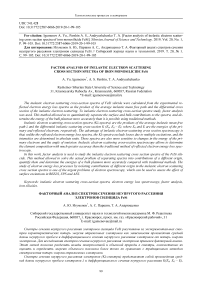Factor analysis of inelastic electron scattering cross section spectra of iron monosilicide FeSi
Автор: Igumenov A. Yu., Parshin A.S., Andryushchenko T.A.
Журнал: Сибирский аэрокосмический журнал @vestnik-sibsau
Рубрика: Технологические процессы и материалы
Статья в выпуске: 1 т.20, 2019 года.
Бесплатный доступ
The inelastic electron scattering cross-section spectra of FeSi silicide were calculated from the experimental re- flected electron energy loss spectra as the product of the average inelastic mean free path and the differential cross section of the inelastic electron scattering. To inelastic electron scattering cross-section spectra study, factor analysis was used. This method allowed us to quantitatively separate the surface and bulk contributions to the spectra, and de- termine the energy of the bulk plasmon more accurately than it is possible using traditional methods. Inelastic electron scattering cross-section spectra (Kλ-spectra) are the products of the average inelastic mean free path λ and the differential inelastic scattering cross-section K (E0, E0 - E), where E0 and E are the energies of the pri- mary and reflected electrons, respectively. The advantage of inelastic electron scattering cross section spectroscopy is that, unlike the reflected electron energy loss spectra, the Kλ-spectra exclude losses due to multiple excitations, and the intensities are determined in absolute units. These spectra are also more sensitive to changes in the energy of the pri- mary electrons and the angle of emission. Inelastic electron scattering cross-section spectroscopy allows to determine the element composition with much greater accuracy than the traditional method of reflected electron energy loss spec- troscopy. In this work, factor analysis is used to study the inelastic electron scattering cross section spectra of the FeSi sili- cide. This method allowed to solve the actual problem of separating spectra into contributions of a different origin, quantify them and determine the energies of a bulk plasmon more accurately compared with traditional methods. The study of electron energy loss processes by isolating contributions of different origin in the inelastic electron scattering cross section spectra is one of the urgent problems of electron spectroscopy, which can be used to assess the effect of surface excitations in REELS, XPS and AES.
Inelastic electron scattering cross-section spectra, electron energy loss spectroscopy, factor analysis, iron silicides
Короткий адрес: https://sciup.org/148321902
IDR: 148321902 | УДК: 543.428 | DOI: 10.31772/2587-6066-2019-20-1-99-105
Текст научной статьи Factor analysis of inelastic electron scattering cross section spectra of iron monosilicide FeSi
Introduction. The successful development of nanoelectronics, nanophotonics and spintronics devices requires compliance with a number of requirements to the methods of structures synthesis on the basis of silicon and the transitional metals and to the methods of their analysis. For such structures research the greatest distribution gained such electronic spectroscopy methods as Augerelectron Spectroscopy (AES), X-ray photoelectron spectroscopy (XPS) and reflected electron energy loss spectroscopy (REELS). Fe-Si system, is of research interest from the fundamental and applied points of view [1]. However, the elemental analysis of iron silicides using XPS and REELS methods is difficult because the values of photoelectron and plasmon peaks energies for silicides with different structure are close to each other [2].
Inelastic electron scattering cross-section spectra ( Kλ- spectra [3]) are the products of the inelastic mean free path λ and the differential cross section for inelastic electron scattering K ( E 0, E 0 – E ), where E 0 and E are the energies of the primary and reflected electrons, respectively. The advantage of inelastic electron scattering cross section spectroscopy is that, unlike the reflected electron energy loss spectra, the K λ - spectra exclude losses due to multiple excitations, and the intensities are determined in absolute units. These spectra are also more sensitive to changes in the primary electron energy and the emission angle [4–6]. Inelastic electron scattering cross-section spectroscopy allows to determine the element composition with much greater accuracy than the traditional method of reflected electron energy loss spectroscopy [6].
In this work, factor analysis (FA) is used to study the inelastic electron scattering cross section spectra of FeSi silicide. This method allowed to solve the actual problem of spectra separating into different origin contributions, quantify them and determine the energies of a bulk plasmon more accurately compared with traditional methods. The study of electron energy loss processes by isolating contributions of different origin in the inelastic electron scattering cross section spectra is one of the urgent problems of electron spectroscopy, which can be used to assess the effect of surface excitations in REELS, XPS and AES [1–15].
Previously [16–21], we studied Si, Fe and FeSi 2 , Fe 5 Si 3 silicides using an author's technique of spectra decomposition into energy loss peaks.
Experimental technique. The iron silicide FeSi is made by alloying of iron and silicon mixture in atomic ratio 1×1 under high vacuum conditions. The mixture was kept at melting temperature for 15 min. then the alloy was crushed and annealed for 15 min. 1 mm thick washers were cut out from bulk samples and after grinding the spectroscopical research was conducted.
Photoelectron spectra and integrated reflected electron energy loss spectra measurements were carried out on the ultra-high vacuum photoelectron spectrometer SPECS (Germany) at angles between the incidence and detecting electrons and the sample surface normal respectively α i = 59°, α d = 0°. The spectrometer is completed with a spherical energy analyser PHOIBOS MCD9, an X -ray tube with the double anode as a source of X-ray radiation, an electronic Microfocus EK-12-M gun (STAIB Instruments) for exaltation of electron energy loss spectra. Surface contamination, protective and oxide layers were removed using argon ions Ar+ etching (accelerating voltage 2.5 kV, ionic current 15 mA) with the raster ion PU-IQE-12/38 (SPECS) gun immediately in the spectrometer camera before electron spectra registration. The completeness of oxygen and contamination removal was controlled with X -ray photoelectron spectra (XPS).
From the experimental reflected electron energy loss spectra using the QUASESTM XS REELS software package (Quantitative Analysis of Surfaces by Electron Spectroscopy cross section determined by REELS) [22], according to the algorithm offered in [23] the inelastic electron scattering cross section spectra – the product of the inelastic mean free path λ and the differential cross section for inelastic electron scattering K(E0, E0 – E) are received. Inelastic electron scattering cross section spectra are defined by electron energy loss T probability at single scattering on the inelastic mean free path λ, related to an energy unit. These spectra maxima values determine probabilities of single energy loss on the surface or bulk exitations. Due to absolute values of energy loss intensity inelastic electron scattering cross-section spectra, in comparison with traditional reflected electron energy loss spectra, allow to carry out comparison and the analysis of different spectra not only on peaks energies, but also on their intensity.
Factor analysis is the statistical method widely used in electron spectroscopy [10]. Application of factor analysis is possible for spectra representing as a linear combination of components which concentration changes during any process. This method is relevant for AES where simple decomposition of spectrum lines on components is impossible as in Auger spectra, besides chemical shift there is also a change of a lines form [11–13]. In electronic Auger spectroscopy FA is used for study the processes of layer-by-layer etching of thin films [12], the processes of adsorption [13; 14].
In [15] XPS method was applied to study chemical changes induced by He+ bunch influence in a natural crystal of pyrite (FeS2). It is shown that the routine analysis use together with FA can be a powerful method of elements identification when changes in bond energy and broadening happen simultaneously. Due to the routine analysis and FA of XPS spectra combination the complete signal Fe 2p XPS was analysed.
As noted in [15], the advantage of FA, in comparison with the XPS routine analysis, is that whole set of spectra is used (usually in XPS each spectrum is separately analysed) and FA does not need the preliminary knowledge of XPS peaks form and position, that allows to get these data using only experimental data. On the other hand, the FA disadvantages is noise component existence and nonideality of a components form, in comparison with XPS results.
The inelastic electron scattering cross section spectra received at various primary electron energy or the angles of falling/detecting electrons represent sequences of data in which the relative contributions of surface and bulk loss change systematically depending on the experimental conditions. In [5] the factor analysis is used as a way of inelastic electron scattering cross section spectra decomposition into two contributions (bulk and surface) in Si and SiO2 research.
Factor analysis is carried out as follows. The matrix which columns are intensity values of energy loss at various primary electron energies is formed. At the first stage the selection of principal factors (components), which provide a spectrum in total, close to the initial, is made. Later, two columns with the greatest intensity – principal abstract factors (principal components) are allocated from the received matrix. Further, these factors conversion is to a matrix of rotation R sin ф cos ф carried out by multiplication (target rotation):
cos ф
R =
- sin ф
Target rotation transforms abstract factors to physical ones by achievement of predetermined criterion of a peak form and the maximum provision. In [5] the Lorentzian peak form corresponding to bulk plasmon exaltation is taken as such criterion and by means of φ angle change the component form, close to the Lorentz peak having a maximum at bulk plasmon energy, is reached. Then the most accurate form of the surface was reached by additional rotation. Further reconstruction of the initial spectrum as a two factors linear combination is carried out.
In this work, unlike [5], the peaks form was not selected close to standard Lorentzian peaks, but to Tougaard peaks form. [24]:
X K =
BT
( C - T 2 ) 2 + DT
The B , C , D parameters are adjustable and for each element have defined values [24]. Parameter B defines peak intensity, parameter C defines the position (influences to position, but does not correspond to it in an explicit form), parameter D defines the width and indirectly influences peak position and intensity. The Tougaard functions (universal classes of inelastic electron scattering cross-section) are used for the description of inelastic electron scattering cross-section spectra.
The three-parametrical Tougaard function was transformed to:
X K =
BT


+ DT 2
where Tp parameter corresponds to the position of a peak maximum in absolute units.
In fig. 1, 2 the model spectrum which consists of 2 unsolved peaks is presented.
A set of such spectra at a different peaks amplitude ratio was considered.
By means of the factor analysis 1 and 2 peaks factors are allocated from initial spectra, they coincide with initial peaks. For an example factors at rotation at different angles (fig. 3, 4) are given.
Experimental results. In fig. 5, 6 FeSi silicide spectra at primary electron energies 300 and 3000 eV are presented. The main maximum energy in FeSi inelastic electron scattering cross-section spectra is close to the bulk plasmon energy [16; 25] and possesses the value 20.1 ± 0.6 eV. The low-energy K λ-spectra area has a weak peak with energy about 3 eV.
These spectra are approximated with the sum of two factors. When receiving actual factors the angle was selected so that the bulk factor was well approximated by the Tougaard peak, similarly for the surface factor, but its form remained irregular, that means the existence of several unsolved peaks of the different origin. In [16; 17] the decomposition of these spectra into the elemental components described by the Tougaard functions was carried out. The method [16–21] allows to allocate a higher quantity of peaks in K λ-spectra than the factor analysis, including separation the surface origin peaks in low-energy spectrum area.
The bulk and surface factors ratio is close to 2 that corresponds to the classic plasmon theory for the free electron gas [26].
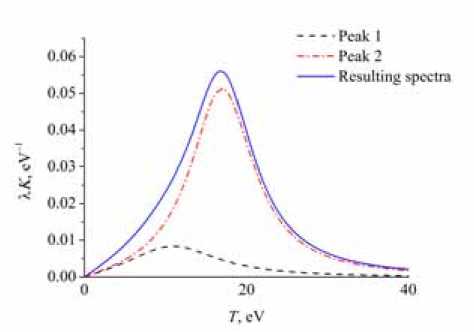
Fig. 1. Model spectrum, peak 1 to peak 2 amplitude ratio 0.2
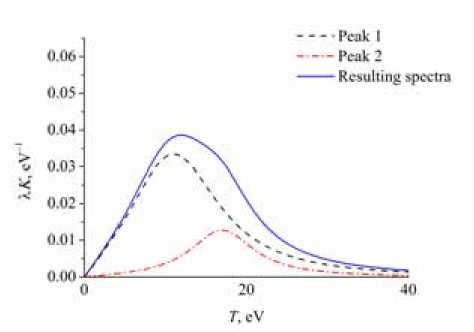
Fig. 2. Model spectrum, peak 1 to peak 2 amplitude ratio 2.6
Рис. 1. Модельный спектр, соотношение амплитуд 1 и 2 пиков 0,2
Рис. 2. Модельный спектр, соотношение амплитуд 1 и 2 пиков 2,6
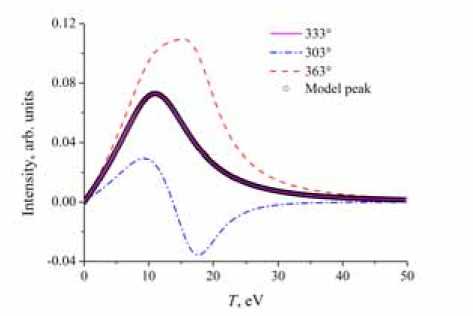
Fig. 3. The peak 1 factor at different angles of rotation
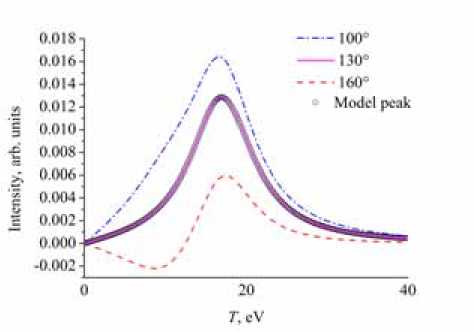
Fig. 4. The peak 2 factor at different angles of rotation
Рис. 3. Фактор пика 1 при разных углах вращения
Рис. 4. Фактор пика 2 при разных углах вращения
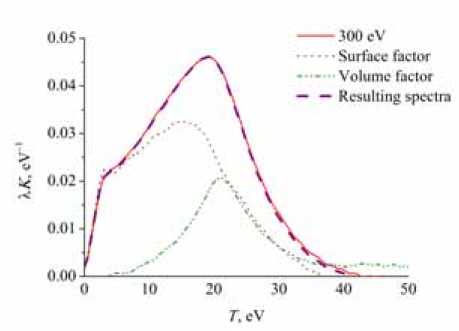
Fig. 5. FeSi spectra at E 0 = 300 eV
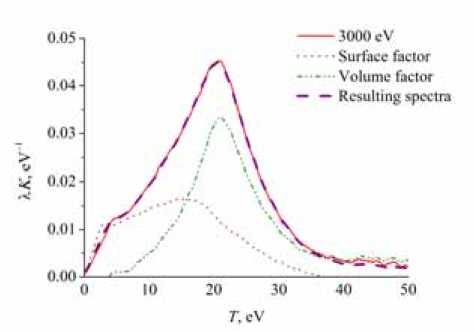
Fig. 6. FeSi spectra at E 0 = 3000 eV
Рис. 5. Спектры FeSi при E 0 = 300 эВ
Рис. 6. Спектры FeSi при E 0 = 3000 эВ
In fig. 7 the primary electron energy dependences of factor amplitudes are presented
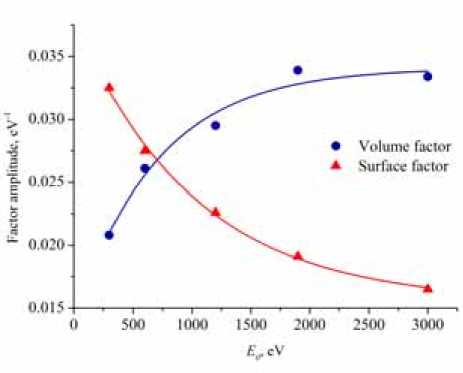
Fig. 7. Primary electron energy dependence of factor amplitudes
Рис. 7. Зависимость амплитуд факторов от энергии первичных электронов
With increasing of primary electron energy the bulk factor amplitude increases, and the surface factor amplitude decreases. This regularity is a confirmation of its origin.
The factor analysis, along with the method of K λ-spectra decomposition on the elemental components described by the Tougaard functions [16–21] can be used for the quantitative assessment of the change of various origin contributions to inelastic electron scattering cross-section spectra.
Conclusion. The applicability of the factor analysis for bulk and surface contributions division in FeSi inelastic electron scattering cross-section spectra has been proved.
The surface and bulk origin contribution separation and quantitative assessment in FeSi inelastic electron scattering cross-section spectra with factor analysis were carried out. Factor amplitudes dependences on primary electron energy reflect their surface and bulk origin.
Список литературы Factor analysis of inelastic electron scattering cross section spectra of iron monosilicide FeSi
- Galkin N. G., Polyarnyi V. O., Gouralnik A. S. Self-organization of β-FeSi2 islands on Si(111)7×7 // Thin Solid Films. 2004. Vol. 464-465. P. 199-203.
- Ohtsu N., Oku M., Satoh K. Dependence of core- level XPS spectra on iron silicide phase // Applied Surface Science. 2013. Vol. 264. P. 219-224.
- Tougaard S., Chorkendorff. I. Differential inelastic electron scattering cross sections from experimental reflection electron-energy-loss spectra: Application to background removal in electron spectroscopy // Physical Review B. 1987. Vol. 35, No. 13. P. 6570-6577.
- Inelastic Scattering Cross Section of Si Determined from Angular Dependent Reflection Electron Energy Loss Spectra / H. Jin, H. Yoshikawa, H. Iwai [et al.] // Journal of Surface Analysis. 2009. Vol. 15, No. 3. P. 321-324.
- Measurement of optical constants of Si and SiO2 from reflection electron energy loss spectra using factor analysis method / H. Jin, H. Shinotsuka, H. Yoshikawa [et al.] // Journal of applied physics. 2010. No. 107. P. 083709, 1-11.

